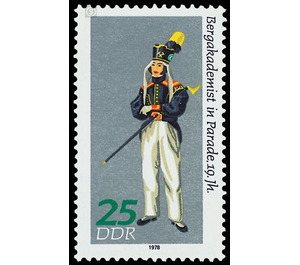Parades from mining and metallurgy - Germany / German Democratic Republic 1978 - 25 Pfennig
Theme: Devices, Items & Instruments
| Country | Germany / German Democratic Republic |
| Issue Date | 1978 |
| Face Value | 25.00 |
| Color | multi-colored grey |
| Perforation | K 12 1/2: 13 |
| Printing Type | offset |
| Stamp Type | Postage stamp |
| Item Type | Stamp |
| Chronological Issue Number | 2062 |
| Chronological Chapter | GER-DDR |
| SID | 325054 |
| In 21 Wishlists | |
Parades from mining and metallurgy The Ministry of Posts and Telecommunications of the German Democratic Republic publishes four multi-colored special postage stamps depicting parade figures from mining and metallurgy. Special cancellations from May 9th to July 8th, 1978 Showpieces from mining and metallurgy Since the 12th century miners in the Saxon Erzgebirge mining silver ore. Her work clothes are known to us through artistic representations and travelogues. Gradually it develops a parade look, which corresponds to magnificent baroque mountain elevators. Miners could rarely get these clothes. A "regulation" of 1768 adapts the "parade mountain habit" to the historical situation. With the new costume rule subordination and distinction should be effected, d. H. the uniform-like Habit expresses the ranking of the divided into eleven classes "Royal Saxon mining state" and the withdrawal of civilian strata. Fashionably, the mountain habit of the so-called "old German costume" is approximated. The miners especially in coal mining resist the wearing of these uniforms. In 1830 a collection of 26 colored engravings with the costumes "according to the latest regulations" was published by G. E. Rost. This work is the basis for this special postage stamp issue. The basic components of the parade look are: Bergkittel, a hip-length, wrinkled robe with a narrow standing and a broad armpit lying on the collar. The smock is closed at the front with 12 buttons, has down-going, buttoned breast pockets. Capuchon, the wide collar underlaid fabric part. Mountain leather (Arschleder) is worn strapped around the waist. Trousers, white pants and stockings are worn. Chess hat, a cylindrical, with green-white cockade, decorated headgear. 25 Pfennig value: Bergakademist in Parade (so-called Extraner) The Bergkittel is from Merino cloth, richly decorated with strings. The national suit includes a broad colored collar and cuffs (colors correspond to mountain areas Freiberg: red). The mountain leather is strapped. The chess hat is covered with black taffeta and decorated with cockade and feather hat. In front of him is the symbol of mining, mallets and iron attached. In the hand of the Bergakademist carries a Steigerhäkchen (work equipment for checking the strength of studs and class symbol).


